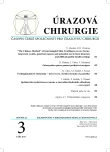-
Medical journals
- Career
Ipsilateral posterior shoulder dislocation and sternoclavicular dislocation – case report
Authors: Ján Palčák 1,2; Pavel Sedlák 1; Igor Čižmář 1,2
Authors‘ workplace: Traumatology department of the University Hospital Olomouc 1; Traumatologické oddělení Fakultní nemocnice Olomouc 1; Faculty of Medicine of Palacky University in Olomouc 2; Lékařská fakulta Univerzity Palackého v Olomouci 2
Published in: Úraz chir. 23., 2015, č.3
Overview
Objective:
The objective of this case report is to present the diagnostic and therapeutic procedure of a rare injury to the shoulder girdle in a middle-aged male patient.Materials and methods:
The authors describe the diagnostic methods and type of surgery in 40 years old patient with acute injury to the right shoulder girdle. The patient was diagnosed with dorsal dislocation of the shoulder and sternoclavicular joint on the same side. The authors did not met with a similar injury combination in the li-terature. The therapeutic objective was treatment of both affected sites. The posterior shoulder dislocation was initially reduced under arthroscopic control, then mini-arthrotomy was performed to refix the subscapularis tendon using a Helix anchor which solved the impression fracture of the humeral head (similar to a reverse Hill-Sachs lesion). Sternoclavicular dislocation was treated by open reduction and fixation of the medial end of the cla-vicle in anatomical position to the sternum using Ortocord fibers. After surgery, the arm was fixed in a brace for four weeks, followed by physiotherapy.Results:
The patient is 6 months after the injury and this treatment regime satisfied with limb function, he is neither limited in daily activities, nor at work or sports. Range of motion of the shoulder joint: flexion up to 170°, rotation (external-internal): 75°-0-45°, abduction 140°. Clavicles are symmetrical.Conclusion:
The described method of treatment is a good option for this rare type of injury, which we recommend based on our modest experience.Key words:
Posterior dislocation of the shoulder, posterior sternoclavicular dislocation, reverse Hill-Sachs lesion, bulb sign.
Sources
1. BORRERO, E. Traumatic posterior displacement of the left clavicular head causing chronic extrinsic compression of the subclavian artery. Physician Sports Med, 1987,15, 87–89.
2. BROWN, RJ. Bilateral dislocation of the shoulders. Injury.1984, 15, 267–273.
3. BUCHOLZ, RW., HECKMAN, JD., COURT-BROWN, CM. et al. Rockwood and greenś fractures in adults. 6th ed. Philadelphia: Lippincott Williams & Wilkins, 2006. 1365–1397.
4. CICAK, N. Posterior dislocation of the shoulder. J Bone Joint Surg Br. 2004, 86, 324–332.
5. CISTERNINO, SJ., ROGERS, LF., STUFFLEBAM, BC. et al. The trough line: a radiographic sign of posterior shoulder dislocation. AJR Am J Roentgenol. 1978, 130, 951–954.
6. DESTOUET, JM., GILULA, LA., MURPHY, WA. et al. Computed tomography of the sternoclavicular joint and sternum. Radiology. 1981,138, 123–128.
7. GLASS, E. et al. Treatment of Sternoclavicular Joint Diclocations: A Systemic Review of 251 Dislocations in 24 Case Series. J Trauma - Injury Infection and Critical Care. 2011, 70,1294–1298.
8. GOVE, N., EBRAHEIM, NA., GLASS, E. Posterior sternoclavicular dislocations: a review of management and complications. Am J Orthop (Belle Mead). 2006, 35, 132–136.
9. GROH, GI., WIRTH, MA. Management of traumatic sternoclavicular joint injuries. J Am Acad Orthop Surg. 2011,19,1–7.
10. GROH, GI., WIRTH, MA., ROCKWOOD, CA. Jr. Treatment of traumatic posterior sternoclavicular Dislocations. J Shoulder Elbow Surg. 2011, 20, 107–113.
11. KOWALSKY, MS., LEVINE, WN. Traumatic posterior glenohumeral dislocation: classification, pathoanatomy, diagnosis and treatment. Orthop Clin North Am. 2008, 39, 519–533.
12. LAFFOSSE, JM., ESPIÉ, A., BONNEVIALLE, N. et al. Posterior dislocation of the sternoclavicular joint and epiphyseal disruption of the medial clavicle with posterior displacement in sport participants. J Bone Joint Surg (Br). 2010, 92B, 103–109.
13. McLAUGHLIN, HL. Posterior dislocation of the shoulder. J Bone Joint Surg Am. 1952, 24, 584–590.
14. ROCKWOOD, CA. Jr, WIRTH, MA. Disorders of the sternoclavicular joint. In: ROCKWOOD, CA. Jr, MATSEN, FA., WIRTH, MA., LIPPITT, SB. The shoulder. . 4th ed. Philadelphia: WB Saunders. 1998, p. 527–560.
15. ROULEAU, DM., HEBERT-DAVIES, J. Incidence of Associated Injury in Posterior Shoulder Dislocation: Systematic Review of the Literature. J Orthop Trauma. 2012, 26, 246–251.
16. SPENCER, EE. Jr., KUHN, JE. Biomechanical analysis of reconstructions for sternoclavicular joint instability. J Bone Joint Surg. 2004, 86, 98–105.
Labels
Surgery Traumatology Trauma surgery
Article was published inTrauma Surgery

2015 Issue 3-
All articles in this issue
- Pelvic Osteosynthesis using computer guided navigation
- Peri-implant fractures - new chalenge. Short review and case history
- Ipsilateral posterior shoulder dislocation and sternoclavicular dislocation – case report
- “The Chinese Method” of Intermingled Skin Grafting in severe burns: long term results, genetical aspects and potential use in burn disasters and difficult public health settings
- Trauma Surgery
- Journal archive
- Current issue
- Online only
- About the journal
Most read in this issue- Ipsilateral posterior shoulder dislocation and sternoclavicular dislocation – case report
- Peri-implant fractures - new chalenge. Short review and case history
- Pelvic Osteosynthesis using computer guided navigation
- “The Chinese Method” of Intermingled Skin Grafting in severe burns: long term results, genetical aspects and potential use in burn disasters and difficult public health settings
Login#ADS_BOTTOM_SCRIPTS#Forgotten passwordEnter the email address that you registered with. We will send you instructions on how to set a new password.
- Career

